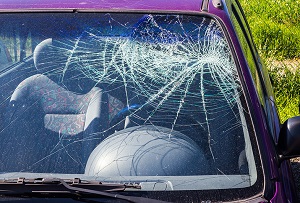There's an old philosophical problem - Say you start collecting sand into a pile. At what point does your pile of sand become a hill? Is there an exact scoop of sand that tips it over from a pile to mound?
A similar thing can happen with your car windscreen. A small chip might not be much to worry about. A crack is cause for concern. But at what point does the damage to your windscreen render your care unsafe and illegal to drive?
And assuming you've got insurance, how will this affect your repairs? Could it be possible to damage the windscreen enough for the car to be an economic write-off?
Let's find out.
Can You Legally Drive a Car with a Damaged Windscreen?
We're specifying "legally" here, because whether you should drive a car with a damaged windscreen is something we'll cover below.
The answer to the question, however, is that "it depends". There are actually legally defined limits for what kind of damage is or isn't acceptable on a windscreen. A window is rejected under the following criteria:
- If the area covered by the windscreen wipers is cracked, discoloured, or otherwise damaged to the extent the driver cannot see well enough to drive safely.
- For laminated windscreens
- if it has a crack that penetrates more than one layer of glass.
- If it has a star or bullseye fracture over 16mm in diameter, or one crack over 150mm in length, in an area that impedes the driver's ability to drive safely.

You can be pulled up and fined, or at least given a notice to repair the damage, if you're caught driving a vehicle with this level of damage.
Don't expect police to be pulling out the tape measure, though; while the guideline might say "150mm" for a hairline crack, for example, you're not likely to get a pass if it's only 145mm.
And does that mean other damage is perfectly fine to drive with?
Again, it's a kind of grey area. If you're found driving with damage to the windscreen, you may be requested to have the car assessed for roadworthiness. It's then at the discression of the tester whether the car passes. You might have fine damage from sand or rocks, for example, that obscures vision or refracts like in a way that makes certain driving conditions more dangerous than normal.
So that draws us pretty nicely to the next point:
Should You Drive a Car with a Damaged Windscreen?
The simple answer is, no.
Even if your damage hasn't reached the legal limits for unroadworthiness, it's really just a matter of time before it does. Every bump or jolt your car experiences will put stress on the existing damage. Over time, it will get worse.
In a best case scenario, it just results in a more severe crack that you get fixed quickly. In worst case scenarios, it can lead part or all of the windscreen shattering spectacularly. Neither is particular safe to drive with.
Damage to the windscreen also risks the integrity of the glass. This can increase the likelihood and severity of injury in the case of a rollover accident.
Can Windscreen Damage Get Your Car Written Off?
Yes, and no.
There are two types of write-off when it comes to insurance claims:
Statutory write-offs, where the car is completely beyond repair. It's delegated to the scrap yard.
Economic or "repairable" write-offs. This is when then insurance company determines that the cost of repair is greater than the cost of paying out the insurance on the car.
A broken windscreen alone isn't going to render a car a statutory write-off in any case. But it might render a car a repairable write-off depending on how much the car was insured for. It's ultimately at the discretion of the insurer; even if you think you can get the car repaired for a reasonable amount, what the insurer says, goes.
If the car is declared a repairable write-off and gets repaired, it can be made roadworthy and even re-sold. It's not uncommon for cars that were repairable write-offs to make it back onto the used car market.
Is It a Good Idea Buy a Repairable Write-Off?
If the damage was something like a broken windscreen, then generally the answer would be "yes". However, you might want to check where the car was repaired and decide if you trust their work.
You can usually see evidence of repair to a windscreen when looking at the glass. Repairs often appear as faint outlines or slightly dull areas on the windscreen. Hairline marks are also sometimes visible where a crack has been repaired. So long as these repair signs don't meet the criteria for obscuring vision we talked about earlier, they're safe to drive with.
There is no legal obligation to inform a buyer that a used car was a repairable write-off; buyers have to check themselves. To do this, they can perform a Revs Check. By using the rego number or VIN of a vehicle on a site like quickrevs.com.au, they can generate a comprehensive car history report in seconds.
The comprehensive car history report generated by a Revs Check will tell you whether the car was ever listed as a repairable write-off, and what reasons were given. If you discover that the car's windscreen was repaired, you can ask the seller for the name of the repair shop, and perform some quick research. If you think the shop was dodgy - you can look elsewhere for a car.